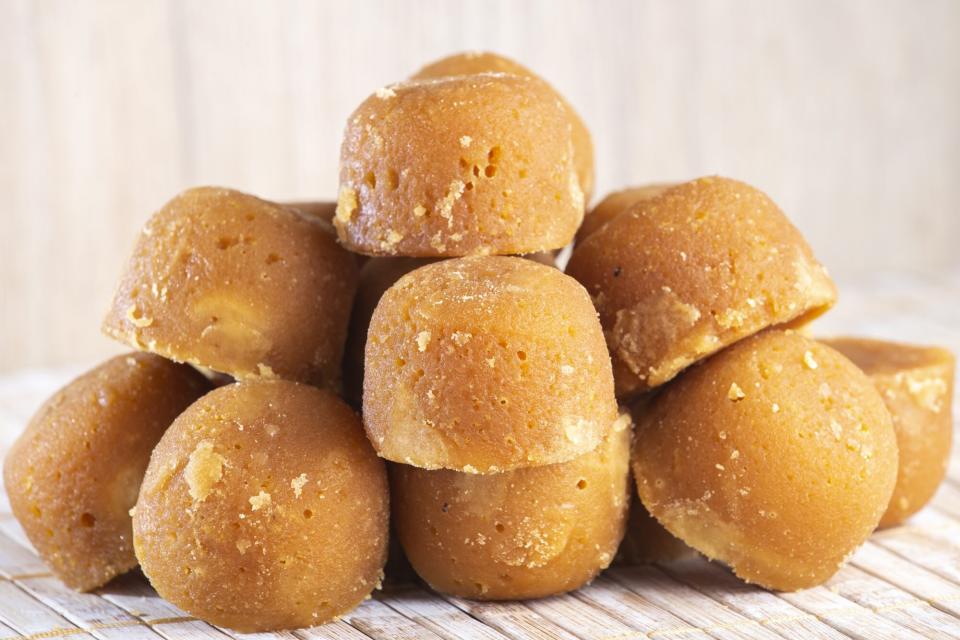What Is Panela Sugar? Learn All About This Popular Sweetener, Including How to Use It at Home
When it comes to natural sweeteners, you can't go wrong with honey or maple syrup, but if you want to expand your arsenal of saccharine ingredients, look no further than panela sugar. Wonderfully sweet and decadent, panela offers a deep flavor profile that can elevate your favorite dishes. But what is panela sugar, and, perhaps most importantly, how do you use it at home? Read on to learn about the sweetener, including our favorite ways to use it in your drinks, desserts, and more.
Related: Maple Syrup Grades Explained So You Know What to Buy
What Is Panela Sugar?
Panela is a type of unrefined cane sugar, and it's traditionally used in Central America, Mexico, Latin America, Portugal, and Spain, says Alice Figueroa, M.P.H., R.D.N., C.D.N., registered dietitian, founder of Alice in Foodieland. It's also similar to jaggery, an unrefined sugar used in Asian cuisines. Typically, panela is made from crushed cane sugar, which is boiled into a liquid and poured into molds to harden, says Traci Weintraub, chef and founder of Gracefully Fed, a Los Angeles-based meal delivery service. The molds might create cones, rectangle blocks, or circular discs, depending on the manufacturer. The solid block can be grated then added to recipes.
What's the Difference Between Panela and White or Brown Sugar?
Like white and brown sugar, panela is made from cane sugar. However, all three ingredients involve different manufacturing processes, resulting in different flavor profiles. Since panela is unrefined, it contains molasses, a dark brown substance that's found in sugarcane leaves. "This gives the product its brown color, as well as a stronger [and more intense caramel] flavor," says Weintraub. In contrast, white sugar has been refined and bleached, so it doesn't contain molasses. This creates sugar with a less intense taste and bright white color. Meanwhile, brown sugar is often refined white sugar with some molasses added back in. It also looks like panela sugar, but the similarities stop there. The process of making brown sugar still involves refining, whereas panela does not. That said, since panela has never had its molasses removed, it has a more complex caramel flavor than brown sugar, says Figueroa.

alexander ruiz / Getty Images
How to Use Panela Sugar
"Panela is beloved in Latin American countries, and it's used in savory, sweet, and sour dishes and beverages," explains Figueroa. Some examples include tepache or chicha (fermented probiotic fruit beverage), aguas frescas (fresh fruit or nut juices), canelazo (cinnamon iced tea), and café de oya (sweetened coffee made in a traditional clay pot). Panela is also used to make traditional pastries, dried fruits, and entrées like enchiladas with panela mole sauce, shares Figueroa.
Panela is available at Latin American grocery stores, as well as some big box supermarkets and local health food stores. For the best quality, look for traditional panela, suggests Figueroa. "The ingredients label should only include organic dehydrated sugarcane juice," she adds. Also, there are two types of panela: morena (dark) or clara (light) panela. "Dark panela may have a deeper flavor than light panela, but both are minimally processed," explains Figueroa.
At the store, you can find panela in several forms: granulated, liquid, or solid blocks. When using solid panela, you can grate the block and use it as you would brown sugar, says Weintraub. Another option is to cut the block into pieces—but be sure to use caution while doing so. Due to its hard consistency, solid panela can be tricky to cut, so Figueroa recommends placing it on steady, secure cutting board and using a sharp knife. Next, you can crush chunks of panela in your food processor or melt them down, shares Weintraub. Or, if you want to soften the entire block, "stick it in the microwave for short intervals, [about] 10 seconds at a time," says Weintraub.
You can also sub panela for white/brown sugar in your favorite recipes at a 1:1 ratio, notes Weintraub. "This applies to most recipes, be it beverage, baking, or cooking," she adds. For example, "if your recipe calls for one cup of white or brown sugar, you can substitute it with one cup of powdered panela," explains Figueroa. Also, you usually don't need to adjust any other ingredients when using panela in place of other sugars, says Weintraub.
If you're looking for inspiration, take a tip from Weintraub: "Coffee sweetened with panela is a must-try. It [creates] a rich, almost caramel-like taste." Additionally, since panela has a molasses-like flavor, it works in any recipe where you might use molasses. "For instance, using panela in gingersnap cookies would make for a delicious upgrade," says Weintraub. Try our Gingersnap Ice Cream Sandwiches for a sweet treat. Panela would work wonderfully in marinades and sauces, she adds, as it will give the condiment more depth and flavor.

